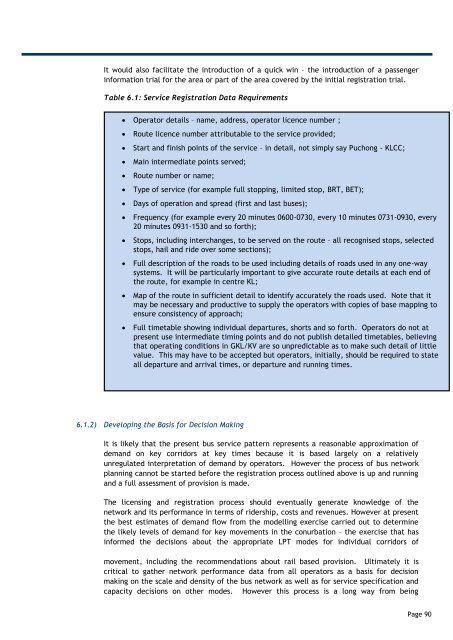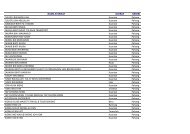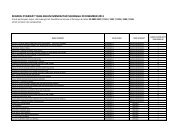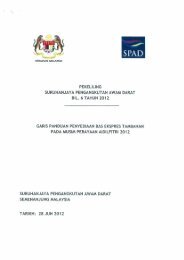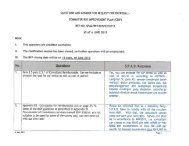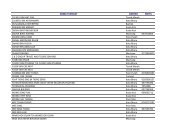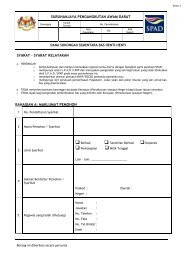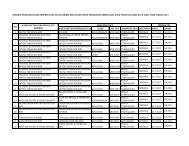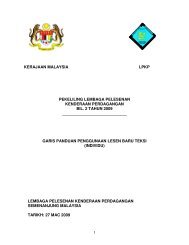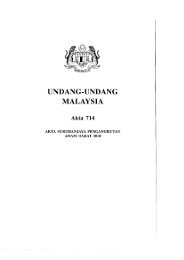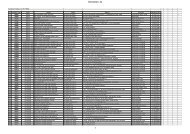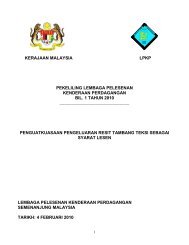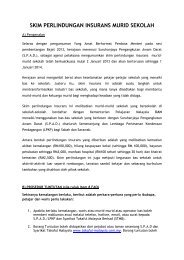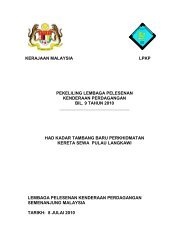Contents - SPAD
Contents - SPAD
Contents - SPAD
You also want an ePaper? Increase the reach of your titles
YUMPU automatically turns print PDFs into web optimized ePapers that Google loves.
It would also facilitate the introduction of a quick win – the introduction of a passenger<br />
information trial for the area or part of the area covered by the initial registration trial.<br />
Table 6.1: Service Registration Data Requirements<br />
Operator details – name, address, operator licence number ;<br />
<br />
<br />
<br />
<br />
<br />
<br />
<br />
<br />
<br />
<br />
<br />
Route licence number attributable to the service provided;<br />
Start and finish points of the service – in detail, not simply say Puchong - KLCC;<br />
Main intermediate points served;<br />
Route number or name;<br />
Type of service (for example full stopping, limited stop, BRT, BET);<br />
Days of operation and spread (first and last buses);<br />
Frequency (for example every 20 minutes 0600-0730, every 10 minutes 0731-0930, every<br />
20 minutes 0931-1530 and so forth);<br />
Stops, including interchanges, to be served on the route – all recognised stops, selected<br />
stops, hail and ride over some sections);<br />
Full description of the roads to be used including details of roads used in any one-way<br />
systems. It will be particularly important to give accurate route details at each end of<br />
the route, for example in centre KL;<br />
Map of the route in sufficient detail to identify accurately the roads used. Note that it<br />
may be necessary and productive to supply the operators with copies of base mapping to<br />
ensure consistency of approach;<br />
Full timetable showing individual departures, shorts and so forth. Operators do not at<br />
present use intermediate timing points and do not publish detailed timetables, believing<br />
that operating conditions in GKL/KV are so unpredictable as to make such detail of little<br />
value. This may have to be accepted but operators, initially, should be required to state<br />
all departure and arrival times, or departure and running times.<br />
6.1.2) Developing the Basis for Decision Making<br />
It is likely that the present bus service pattern represents a reasonable approximation of<br />
demand on key corridors at key times because it is based largely on a relatively<br />
unregulated interpretation of demand by operators. However the process of bus network<br />
planning cannot be started before the registration process outlined above is up and running<br />
and a full assessment of provision is made.<br />
The licensing and registration process should eventually generate knowledge of the<br />
network and its performance in terms of ridership, costs and revenues. However at present<br />
the best estimates of demand flow from the modelling exercise carried out to determine<br />
the likely levels of demand for key movements in the conurbation – the exercise that has<br />
informed the decisions about the appropriate LPT modes for individual corridors of<br />
movement, including the recommendations about rail based provision. Ultimately it is<br />
critical to gather network performance data from all operators as a basis for decision<br />
making on the scale and density of the bus network as well as for service specification and<br />
capacity decisions on other modes. However this process is a long way from being<br />
Page 90


